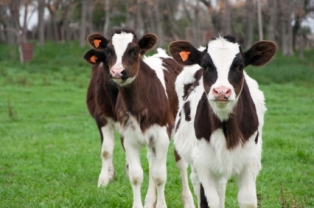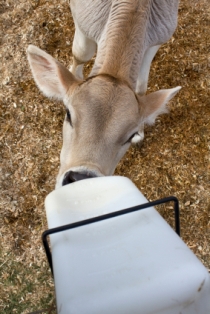Hand rearing calves is a popular business for small farmers. The initial investment required for calf rearing is relatively low while labour can generally be easily worked around off-farm commitments.
Here are some tips on raising calves on a small or hobby farm – focusing on how and what to feed them.
First feed: colostrum
Newborn calves must receive 2 to 3 litres of new colostrum within 12-24 hours of birth, although preferably within the first six hours. If you’re unsure if the colostrum you acquire is suitable, test it with a brix meter and look for readings higher than 25%.
Newborn calves require colostrum within 12 to 24 hours of birth, preferably within the first six.
After receiving an initial gut-fill of colostrum, a calf will be content to lie down and rest. Leave it for 12 hours before attempting to train it to feed. This is not at all cruel. After calving, a cow will often feed her calf then leave it quietly to rest while grazing for a considerable length of time before returning.
 |
Teaching calves to drink
To train a calf to drink, start by dipping your fingers in warm milk and direct it to a warm moist teat to suckle. Having waited 12 hours, most calves will start sucking immediately but if it resists, persist for a little while then return in a few hours to try again. The key is to be patient, quiet and gentle and to not upset the calf. Unless sick, every calf will eventually start drinking.
Always use a teat system for feeding as calves drink better that way. Sucking on teats promotes saliva, an important first step for food digestion, and avoids problems associated with drinking too fast. Calves have been known to drop dead after drinking directly from buckets.
Calves rear better off teat feeding systems compared to being bucket-fed.
Milk requirements
For the first two weeks, feed calves twice daily. Thereafter, they can be fed once daily – best in the afternoon so they get to sleep with a full stomach. Calves will need about 5 litres of full cream milk per calf daily until weaning at 7 to 8 weeks of age. They should be putting on about 500 grams of body weight daily up to weaning. A Frisian calf is likely to weigh 90-100kg by then.
 |
Unless you have access to fresh full cream milk, you will need to use full cream milk powder. Under no circumstances use skim milk powder. Do not dilute milk as this causes scours. Also, ensure milk always at least has the chill taken off it since cold milk can cause scours.
Feeding calf meal allows less milk to be fed, lowering the cost of rearing. Meal can be introduced after 1 week and continued until weaning. Choose a quality calf meal with a high protein content and follow the manufacturer's recommendations.
Fresh drinking water
From the outset, ensure calves have access to clean fresh water. Check the water daily to ensure it is always fresh and clean. Calves need to learn to drink water even when they get milk to drink. Come weaning, they will then know how to drink water and will not suffer the check in growth that many experience.
Solid feed requirements
The overall goal for raising calves profitably is to have them ruminating properly as soon as possible so they can convert lower-cost pasture into bodyweight.
This won't be achieved by feeding milk and meal alone. It requires allowing calves access to quality hay and fresh pasture from one week's age right through to weaning. Hay provides the necessary fibre and straw length to initiate rumination. It also aids meal digestion by allowing the meal within the stomach contents to bind and initiate correct ruminant activity. Avoid over-feeding calves with milk and meal as this will discourage them from foraging for pasture and hay, resulting in delayed rumen development.
Hay for calves should be of the highest quality, i.e. high in pasture grass leaf and clover leaf content. Make hay readily accessible in their pens by placing it off the ground behind coarse gauge sheep netting or similar. Keep supplies fresh and replenish them daily, even if only a little is initially used.
Allowing calves daily access to fresh quality pasture ensures they become familiar with it and are eating pasture properly by weaning. Eating pasture is also how many of the beneficial microbes essential for proper rumen development are introduced to a calf's stomach.
Any pastures offered should be fresh and leafy with good clover content. Where this is not possible, substitute this portion of their diet with extra meal and quality hay.
Allow calves access to fresh quality pasture from 1 week of age.
Mineral supplements
It is strongly recommended calves be supplemented minerals as they are often born with insufficient amounts. Copper is a prime example of an essential element required for optimal calf growth, which raw cow’s milk is naturally low in. Your local veterinarian will have mineral formulations suitable for adding to calf milk or meal. Sodium, in the form of common salt, is also a valuable mineral addition to calf milk.
Add this to the milk and later to the water at a rate of 2g per calf from 1 week of age rising to 8g per calf by weaning. Salt is important for proper development of the rumen as well as for metabolic regulation (it helps calves keep warm and cool as necessary). Salt is also very useful for encouraging calves to drink sufficient water from troughs after weaning, but this will work only if they’re familiar with its taste prior to this.
Where to from here?
For further information on rearing calves we recommend you purchase a copy of Calf Rearing – A Practical Guide. This book provides small farmers with information on calf biology, evaluating alternative feed resources, and developing a full management strategy for calf rearing. The next article in this series Calf housing and bedding requirements for successful calf rearing will discuss calf rearing facilities and expand further on some of the animal health aspects of raising calves.
About the author
 |
The author, Roger Martyn has spent 20 plus years working in agriculture and horticulture since graduating from Massey University with an Agricultural Science degree. He has helped many farmers improve their farm productivity and profitability as well as often increasing the enjoyment they got out of farming. |



